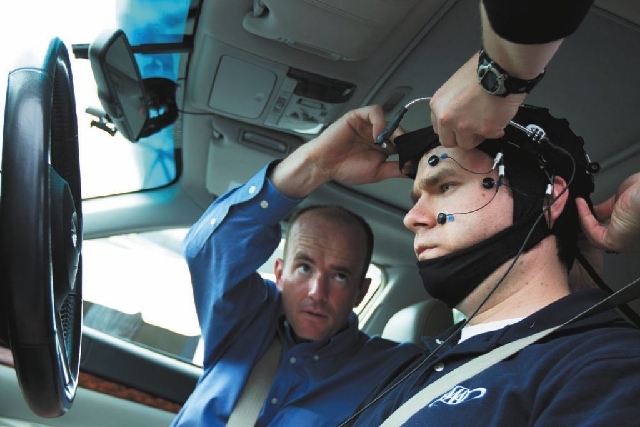AAA study: Hands-free texting still distracting for drivers

WASHINGTON — Using voice commands to send text messages and emails from behind the wheel, which is marketed as a safer alternative for drivers, actually is more distracting and dangerous than simply talking on a cellphone, a new AAA study found.
Automakers have been trying to excite new-car buyers, especially younger ones, with dashboard infotainment systems that let drivers use voice commands do things like turning on windshield wipers, posting Facebook messages or ordering pizza. The pitch has been that hands-free devices are safer because they enable drivers to keep their hands on the wheel and their eyes on the road.
But talking on a hands-free phone isn’t significantly safer for drivers than talking on a hand-held phone, and using hands-free devices that translate speech into text is the most distracting of all, researchers found. Speech-to-text systems that enable drivers to send, scroll through, or delete email and text messages required greater concentration by drivers than other potentially distracting activities examined in the study like talking on the phone, talking to a passenger, listening to a book on tape or listening to the radio.
The greater the concentration required to perform a task, the more likely a driver is to develop what researchers call “tunnel vision” or “inattention blindness.” Drivers will stop scanning the roadway or ignore their side and rearview mirrors. Instead, they look straight ahead, but fail to see what’s in front of them, like red lights and pedestrians.
“People aren’t seeing what they need to see to drive. That’s the scariest part to me,” said Peter Kissinger, president and CEO of the AAA Foundation for Traffic Safety, the group’s safety research arm. “Police accident investigative reports are filled with comments like the ‘looked, but did not see.’ That’s what drivers tell them. We used to think they were lying, but now we know that’s actually true.”
There are about 9 million cars and trucks on the road with infotainment systems, and that will jump to about 62 million vehicles by 2018, AAA spokeswoman Yolanda Cade said, citing automotive industry research. At the same time, drivers tell the AAA they believe phones and other devices are safe to use behind the wheel if they are hands-free, she said.
“We believe there is a public safety crisis looming,” Cade said. “We hope this study will change some widely held misconceptions by motorists.”
AAA officials who briefed automakers, safety advocates and the National Highway Traffic Safety Administration on the study’s findings said they want to limit in-vehicle, voice-driven technologies to “core driving tasks.”
The Alliance of Automobile Manufacturers was skeptical. “We are extremely concerned that it could send a misleading message, since it suggests that hand-held and hands-free devices are equally risky,” the association said in a statement.
The automakers’ trade group said the AAA study focuses only on the mental distraction posed by using a device and ignores the visual and manual aspects of hand-held versus hands-free systems that are integrated into cars.
Other studies have also compared hand-held and hands-free phone use, finding they are equally risky or nearly so. But a recent National Highway Traffic Safety Administration study of drivers’ real world driving experiences found hand-held phone use was less safe than hands-free.
Researchers at the University of Utah who conducted the study for the AAA measured the brainwaves, eye movement, driving performance and other indicators of 32 university students as they drove and performed a variety of secondary tasks, ranging from listening to music to sending emails. Cameras were mounted inside the car to track drivers’ eye and head movements. A device that drivers pressed was used to record their reaction time to red and green lights introduced to their field of vision. Drivers were fitted with a special skull cap to record their brain activity.
The students were tested while not driving, while driving in a simulator and while driving a car on a 3-mile loop through a suburban Salt Lake City neighborhood with stop signs and stoplights. A researcher with a backup braking system accompanied the students in the test car.
One reason using voice commands is so much more distracting for drivers, even though they aren’t using their hands, is that they often require more concentration than simply speaking to another person, said University of Utah psychology professor David Strayer, an expert on cognitive distraction and lead author of the study. Talking to a computer requires far greater precision than talking to a person, he said. Otherwise, “Call home” may get you Home Depot.
Synthetic computer voices can be harder to understand than human voices, also requiring more attention. The computers used in the study were exceptionally high-fidelity systems that made no errors, but the systems in cars aren’t as good, Strayer said. He said that means the study probably underestimates the concentration required of drivers, and thus the ability of speech-to-text systems to distract them.
Another difference: In phone conversations, a person who is listening will give indications that they agree with what the speaker has said or have heard what was said. Computers don’t provide that feedback.
“The complexity of trying to say something that is coherent when there is no feedback is much more difficult,” Strayer said.
A simple, quick voice command to turn on windshield wipers isn’t very distracting, he said. But concentrating on creating a text message and trying to get it right takes a great deal more mental effort and time.
“The more complex and the longer those interactions are, the more likely you are going to have impairments when you’re driving,” Strayer said.
———
Follow Joan Lowy on Twitter at http://www.twitter.com/AP—Joan—Lowy












